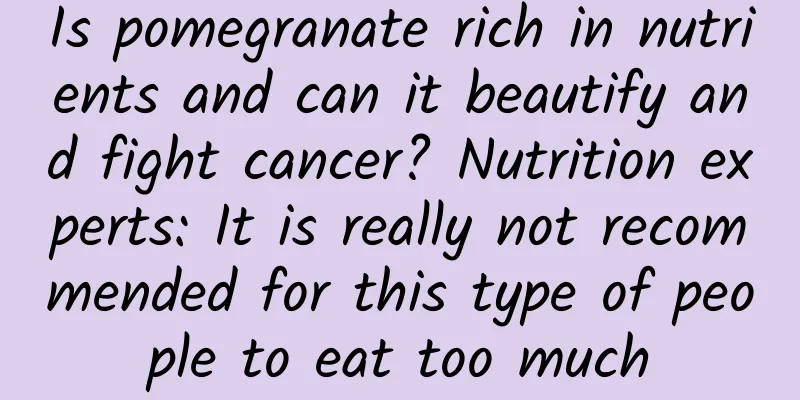Is pomegranate rich in nutrients and can it beautify and fight cancer? Nutrition experts: It is really not recommended for this type of people to eat too much

|
gossip There are so many seasonal fruits in autumn, but the most delicious one has to be pomegranate! Some pomegranates are sweet and sour, while others are pure sweet and juicy. The soft-seeded pomegranates are especially delicious! You can’t stop eating them. The mature pomegranate is bright red in appearance. It is often used as a festive fruit because of its bright color and plump seeds. Now is the season for eating pomegranates. One large pomegranate a day is both thirst-quenching and delicious. Some people say that pomegranates are known as the "Chinese divine fruit" and are very nutritious; others say that pomegranates can beautify and fight cancer. What are the benefits of eating pomegranates? How should people with high blood sugar eat pomegranates? In this article, we will talk about pomegranates. analyze Pomegranate Nutrition and Health Benefits Pomegranate is native to Iran, Afghanistan and other countries along the Mediterranean coast. It was introduced to China via the Silk Road during the Han Dynasty and has a cultivation history of more than 2,000 years. Copyrighted stock images, no reproduction is authorized Pomegranate is known as the "Magic Fruit of China", which makes people mistakenly believe that it is rich in nutritional value. In fact, most of the nutrients in pomegranate are at average levels. Apart from its good hydrating effect, only two nutrients are more prominent. Dietary fiber: The insoluble dietary fiber content of pomegranate is 4.9g/100g, [1] which is considered high among fruits and nearly three times that of apples. It can promote gastrointestinal mechanical movement, aid defecation, prevent constipation, and promote intestinal health. Mineral potassium: The potassium content of pomegranate is 231 mg/100 g, [1] which is comparable to the potassium content of bananas, which are known as potassium-rich fruits. Adequate potassium intake helps stabilize blood pressure, which is quite friendly for people who need to control blood pressure. In addition to the above two nutrients, pomegranates can also provide us with some antioxidant ingredients, including gallic acid, chlorogenic acid, caffeic acid, protocatechuic acid, catechins and coumaric acid. [2] Taking more phenolic substances can help us resist oxidation and inflammation, but don’t expect eating them to beautify you or prevent cancer. As for the vitamin C in pomegranate, the content is not very high. The data in the "Chinese Food Composition Table" shows that the vitamin C content in pomegranate is only 8mg/100g, which is the same as the vitamin C content in banana. Although it is nearly 3 times that of apple, it is far behind oranges and kiwis! It is only about 1/8 of that of kiwis. However, there are documents showing that the vitamin C content of Kashgar pomegranate pulp can reach 681.9 mg/100 g, and the vitamin C content of Hotan pomegranate and Shaanxi pomegranate is also around 600 mg/100 g. [3] The vitamin C content of Heyin soft-seeded pomegranate is also relatively high, at 408.5 mg/100 g. [4] This may be due to differences between different varieties, and the data varies greatly, which needs further verification. Image source: Reference [3] Soft-seeded pomegranate is good Many pomegranates have seeds, and you have to spit out the seeds while eating, which is really troublesome! It doesn’t matter, you can choose a pomegranate with soft seeds. Copyrighted stock images, no reproduction is authorized Soft-seeded pomegranates are popular because of their soft and edible seeds. In particular, the Tunisian soft-seeded pomegranate is one of the most popular soft-seeded pomegranate varieties on the Chinese market. It was introduced to my country from Tunisia in 1986 and its price is 2 to 4 times that of ordinary pomegranate varieties. There are many places in my country where Tunisian soft-seeded pomegranates are produced. Researchers compared Tunisian soft-seeded pomegranates from 13 places and found that the Tunisian soft-seeded pomegranates from Jianshui, Yunnan have the highest soluble sugar content, the highest sugar-acid ratio, the sweetest taste, and the largest fruit, with a single fruit weight of up to 880 grams; the soft-seeded pomegranates from Zhengzhou, Henan have the thinnest peel. [5] Can I eat pomegranate if I have high blood sugar? The sugar content of pomegranates is quite high, at 13.7%,[6] which is slightly higher than the total sugar content of bananas,[7] and some varieties of pomegranates have even higher sugar content. The main sugar components of pomegranate fruit are sucrose, glucose, fructose and sorbitol. Glucose and fructose have the highest content, with fructose accounting for 9.18% to 50.67% of the total sugar, and glucose accounting for 43.84% to 48.36% of the total sugar. Sucrose and sorbitol are only small amounts. [8] Although the metabolism of fructose has little effect on blood sugar, the metabolism of glucose has a relatively large impact on blood sugar. People with high blood sugar and diabetes should eat less. If you like, you can eat 100 grams each in the morning and afternoon as a snack, and pair it with a few nuts to help stabilize blood sugar. A small bowl of soft-seeded pomegranate weighs about 200 grams. Image source: Photo by the author It is important to note that you should not drink pomegranate juice in large quantities to avoid a spike in blood sugar. Data show that the glycemic load (GL) of pomegranate juice is 21,[9] and a GL>10 means that it has a greater impact on blood sugar. Pomegranate is the most delicious fruit in autumn. A big spoonful of pomegranate is sweet and delicious, full of juice! Friends who like to eat pomegranates should make arrangements quickly, don't miss the opportunity! in conclusion Pomegranates are good at replenishing water, rich in dietary fiber and mineral potassium, but other nutrients are not prominent. In addition, pomegranates contain some phenolic substances. Taking more phenolic substances can help us resist oxidation and inflammation, but they have no beauty or anti-cancer effects. References: [1] Yang Yuexin. Chinese Food Composition Table 6th Edition Volume 1[M]. Peking University Medical Press, 2018 [2] Yang Hongpeng, Li Xi, Xu Tong, et al. Determination of antioxidant components in pomegranate fruit and peel[J]. Chinese Food and Nutrition, 2021, 27(09): 39-41. DOI: 10.19870/j.cnki.11-3716/ts.2021.09.003. [3] Wang Ping, Liang Jiao, Li Shugang. Study on the difference of nutritional components of pomegranate from different origins[J]. Food Industry, 2017, 38(04): 297-301. [4] Yan Shenghui, Li Xingkui, Gao Yuhong. Nutritional value analysis of Heyin soft-seeded pomegranate[J]. Hubei Agricultural Sciences, 2015, 54(24): 6376-6378+6382. DOI: 10.14088/j.cnki.issn0439-8114.2015.24.073. [5] Liu Chunyan, Qin Gaihua, Li Jiyu, et al. Fruit quality evaluation of 'Tunisian soft seed' pomegranate and analysis of main evaluation factors [C]//Pomegranate Branch of Chinese Society of Horticulture. Research progress of Chinese pomegranate (III) - Proceedings of the 3rd Member Representative Conference of Pomegranate Branch of Chinese Society of Horticulture and the 1st China Sihong Soft Seed Pomegranate Summit Forum and the Preparatory Meeting of the National Pomegranate Industry Science and Technology Innovation Alliance. China Forestry Publishing House, 2018:7.DOI:10.26914/c.cnkihy.2018.001952. [6] https://fdc.nal.usda.gov/fdc-app.html#/food-details/169134/nutrients [7] https://fdc.nal.usda.gov/fdc-app.html#/food-details/173944/nutrients [8] Qin Gaihua, Huang Wenjiang, Zhao Jianrong, et al. Sugar and acid composition and flavor characteristics of pomegranate fruit[J]. Journal of Tropical Crops, 2011, 32(11): 2148-2151. [9] Sydney University's Glycemic Index ResearchService (Human Nutrition Unit, University ofSydney, Australia), unpublished observations.2009 Source: Science Popularization China Author: Xue Qingxin, member of Chinese Nutrition Society, registered nutritionist, health manager, public nutritionist Reviewer: Zhang Na, Associate Researcher, Doctoral Supervisor, Peking University School of Public Health The article is produced by "Science Popularization China". Please indicate the source when reprinting. The cover image and images within this article are from the copyright gallery. Reprinting and quoting them may lead to copyright disputes. |
<<: The ocean is running a fever: Will extreme weather bring us into an era of "boiling"?
>>: Why do unoccupied houses age so quickly?
Recommend
As mobile phone screens get bigger and bigger, what challenges do UX designers face?
Editor's note: Since the iPhone X was launche...
How to develop a financial accounting mini program and a financial diary mini program?
With the economic downturn, many people have begu...
Please be kind to your programmers, otherwise hum!
[[127840]] Yan, a programmer born in the 1990s, w...
E-commerce operations: traffic source analysis
For e-commerce platforms, accurately identifying ...
10 new customer acquisition methods you must know in the early stages of product promotion!
Many Internet products rely on a single breakthro...
[Chasing Dreams among Stars] Zhang Qianggong: Standing on the Roof of the World, Listening to the Voice of the Earth
Your browser does not support the video tag The Q...
First experience with Hujiang Online School’s CET-4 smart course: Is it reliable to pass the CET-4 easily for 29 yuan?
For many college students, CET-4 has become an un...
Some scientists not only don't take a holiday, but are also ready to tell you about a discovery that took them ten years to develop.
Author: Liu Yun, Wang Bo, Shi Gongle (Nanjing Ins...
Bringing a 100-inch giant screen cinema home has never been so easy: one person can come to your home and install it in half an hour
In the long history of the development of the tel...
Please accept it! A comprehensive guide to Android Market ASO optimization tutorial!
Today we will make a simple summary, that is, bri...
iOS9 Learn more every day 3 :: Storyboard References
[[142029]] If you have ever used interface builde...
Red, yellow, pink...why have I never seen black flowers?
When we go to the flower market, we always see so...
How much does it cost to develop a Xuancheng luggage mini program? What is the investment quotation for Xuancheng luggage mini program?
How much does it cost to attract investment in th...
To B & To C: Are the operations of To B products really different?
Common concepts of To B operations and To C opera...
The business methodology of live e-commerce
Judging from the monthly active user scale of sev...









